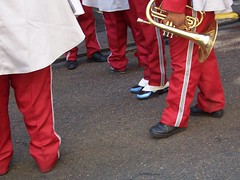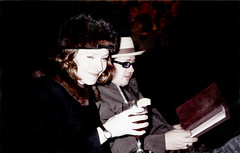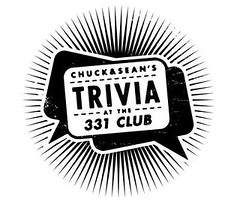 There's no local opportunity to watch a group of black men in black face, pompously smoking oversized cigars and laconically tossing hand-painted coconuts to desperate parade goers. You can't end a parade here by wandering up the street to the Mother-In-Law Lounge, formerly owned by R&B great Ernie K-Doe (whose biggest hit was called "Mother-In-Law," natch), and is now bartended by his excitable widow Antoninette, who keeps a life-sized wax statue of her husband on hand, dressed in the plumage of a Mardi Gras Indian. Ernestine even takes the statue with her to parades. At least, she did before Katrina, and before the Mother-In-Law Lounge partially filled with water from Lake Pontchartrain. I've only been back to New Orleans once since I left, to rescue my belongings, and at that time Ernestine's neighborhood, Treme, still looked as though a bomb had been dropped on it. I hear the lounge is back on its feet now, and good for it.
There's no local opportunity to watch a group of black men in black face, pompously smoking oversized cigars and laconically tossing hand-painted coconuts to desperate parade goers. You can't end a parade here by wandering up the street to the Mother-In-Law Lounge, formerly owned by R&B great Ernie K-Doe (whose biggest hit was called "Mother-In-Law," natch), and is now bartended by his excitable widow Antoninette, who keeps a life-sized wax statue of her husband on hand, dressed in the plumage of a Mardi Gras Indian. Ernestine even takes the statue with her to parades. At least, she did before Katrina, and before the Mother-In-Law Lounge partially filled with water from Lake Pontchartrain. I've only been back to New Orleans once since I left, to rescue my belongings, and at that time Ernestine's neighborhood, Treme, still looked as though a bomb had been dropped on it. I hear the lounge is back on its feet now, and good for it.But what's a former resident of the French Quarter to do in Minneapolis when Mardi Gras rolls around? I won't be going to any parades, and the local businesses that offer Mardi Gras-themed events don't really know what they are undertaking, and how far they will fall from the mark.
All I can do is drink.
When friends would visit me in the City that Care Forgot, I took them on my very own tour of the city. A drinker's tour. New Orleans is home to some very old bars, and it is home to some very old drinks, and what better way to spend an afternoon than wandering the city on foot, visiting the holy sites of one of the world's drinking Meccas? Of course, it wouldn't take long for wandering to turn to staggering, particularly once the tour reached Bourbon Street, which features some of the city's worst but most potent drinks.
I might not be in New Orleans for this Mardi Gras, and I may not be able to roam the city of New Orleans as I once did, but, god damn it, I do have a liquor cabinet, and so I plan to revisit the city, if only through its cocktails. Join me, won't you?
1. LET'S BEGIN AT THE BIRTHPLACE OF THE COCKTAIL, 437 Royal Street, in the French Quarter. You can still visit the site, a former pharmacy, although you can't get a cocktail here -- it's now an antique store that specializes in rare coins and Civil War-era weapons. Nonetheless, there is a little marker of the locations historic importance, an egg cup of the sort that was used to serve the first cocktail, and a notice that informs us that the French word for egg cup, cocquetier, is likely the source of the word cocktail. This is disputed, as is the location's claim to having originated the cocktail, but these things are always disputed, and the dispute isn't likely to be resolved. So this is as good a place as any for the cocktail to have started, and better than some.
 The drink in question is a marvelous concoction called the sazerac, which any good bartender in New Orleans knows how to make, and no other bartender anywhere else seems to be able to manage. It was created by a Creole pharmacist named Antoine Peychaud in the 1800s, and, when he invented it, the drink was composed of cognac, absinthe, and bitters -- an excellent brand of bitters still bears Peychaud's name. The drink didn't get its name until a fellow named Sewell Taylor opened a bar called The Sazerac Coffeehouse in 1853, and made the drink with a brand of cognac called Sazerac-du-Forge et fils. Usually the drink is now made with rye whiskey, but it can still be made with cognac, if you are so inclined. The bar is still around now in the Fairmont Hotel on Baronne Street, and, if you're in New Orleans, that's just the place to get yourself a sazerac. But you're not in New Orleans at just this moment, and there's not going to be a bartender who can make one for you, so you're going to have to make one for yourself. Here's how:
The drink in question is a marvelous concoction called the sazerac, which any good bartender in New Orleans knows how to make, and no other bartender anywhere else seems to be able to manage. It was created by a Creole pharmacist named Antoine Peychaud in the 1800s, and, when he invented it, the drink was composed of cognac, absinthe, and bitters -- an excellent brand of bitters still bears Peychaud's name. The drink didn't get its name until a fellow named Sewell Taylor opened a bar called The Sazerac Coffeehouse in 1853, and made the drink with a brand of cognac called Sazerac-du-Forge et fils. Usually the drink is now made with rye whiskey, but it can still be made with cognac, if you are so inclined. The bar is still around now in the Fairmont Hotel on Baronne Street, and, if you're in New Orleans, that's just the place to get yourself a sazerac. But you're not in New Orleans at just this moment, and there's not going to be a bartender who can make one for you, so you're going to have to make one for yourself. Here's how:THE SAZERAC
teaspoon of simple syrup (or 1 sugar cube or 1 teaspoon of granulated sugar)
3 - 4 dashes Peychaud's bitters
2 ounces rye whiskey (typically, Old Overholt)
1/4 teaspoon Herbsaint, an anise liqueur from New Orleans, although pastis will do in a pinch
Strip of lemon peel
Pour a few drops of Herbsaint in an old fashioned glass, swirling it around to coat the glass. Pour out any residue. Add ice to a cocktail shaker, add simple sugar, rye whiskey, and bitters. Stir gently until the drink is cold. Strain into glass. Twist lemon peel into drink, then add as garnish.
2. WHILE WE'RE ON THE SUBJECT OF ABSINTHE, which is, as any of you regular drinkers know, both illegal and easy to obtain in the United States, we should move on to an absinthe cocktail. I generally began my drinking tour of the city with absinthe, but my reasons were suspect. Firstly, I lived close to a Pirate Alley bar that served a contemporary version of the drink called Absente, and the bartender there was a fellow named Rick, who actually dressed as a pirate and carried loaded black powder pistols with him. Once, there was a rumor going round that the Pirate's Alley bar was going to be robbed, and so Rick brought in his collection of muskets, loaded them, and readied himself to do battle with his robbers. They never showed, perhaps having glanced in and seen a pirate standing guard with a brace of antique muskets and pistols on hand. It was an impressive way to start a day of drinking, and absinthe is an impressive drink to start drinking with, as it is reported to double the effects of any drink that follows it.
 I won't tell you how to get hold of absinthe, and, if you can't, feel free to use Herbsaint, which started life as an absinthe, or any pastis, which have the anise flavor of absinthe without the wormwood that makes the drink illegal. The cocktail we're going to make is called the Absinthe Frappe, and it spawned a national craze in the early part of the 20th century, including its own pop song, which included these lyrics:
I won't tell you how to get hold of absinthe, and, if you can't, feel free to use Herbsaint, which started life as an absinthe, or any pastis, which have the anise flavor of absinthe without the wormwood that makes the drink illegal. The cocktail we're going to make is called the Absinthe Frappe, and it spawned a national craze in the early part of the 20th century, including its own pop song, which included these lyrics:I will free you first from burning thirst
That is born of a night of the bowl,
Like a sun 'twill rise through the inky skies
That so heavily hang o'er your souls.
At the first cool sip on your fevered lip
You determine to live through the day,
Life's again worth while as with a dawning smile
You imbibe your absinthe frappe.
You can still order an Absinthe Frappe in New Orleans, at a Bourbon Street bar called The Old Absinthe House, appropriately enough, although they make it with Herbsaint. Here's how to make it yourself:
THE ABSINTHE FRAPPE
Fill a rocks glass with crushed ice add:
1 1/4 ounce of absinthe or Herbsaint
1/4 ounce of Anisette
top with a splash of soda water
3. MY FAVORITE RESTAURANT in the Quarter was a place called the Napoleon House, a former home to the city's mayor from 1812 to 1815, who supposedly gave the house to Napoleon Bonaparte to live when the emperor escaped his island exile on Saint Helena, which he never did, dying instead. It's now a lovely bar restaurant featuring a sort of dark, decaying elegance, a terrific menu, classical music, and a specialty drink. The drink is the Pimm's Cup.
Pimm's is one of those alcohols that you find on the liqueur shelf-- nobody ever seems to buy it-- and in any well-stocked bar, where nobody ever seems to order it. One assumes this is because nobody has any idea what it is -- the exact ingredients are a carefully guarded secret, purportedly known by only six people in the world. But folks who have tried the Pimm's Cup are often mad about it, and many of them tried it for the first time at the Napoleon House. A surprising number of local bartenders pour a good Pimm's Cup, and you'll know they know their business if they ask you whether you prefer 7-Up or ginger ale as the mixer, and you'll know they really know their stuff if they also offer lemonade as an option. The best garnish for the drink is a cucumber slice, and bars that have those on hand are worth remembering.
PIMM'S CUP
Fill a tall 12 oz glass with ice and add 1 1/4 oz. Pimm's #1 and 3 oz lemonade.
Then top off with 7up.
Garnish with cucumber.
 4. THERE ARE, if you can believe it, two bars that spin within blocks of each other in New Orleans. The first is at the top of the city's World Trade Center, now called Altitude33, and is a rather tacky contemporary bar that nonetheless offers a spectacular panoramic view of the city. The better option is the Carousel Bar, nestled near the entrance to the Monteleone Hotel on Royal Street. As it's name suggests, the bar is designed to look like a carousel, and it makes a slow rotation around the bartenders, who don't seem to mind it. The bar offers two specialty drinks, one a fruity beverage called The Goody, which is a rather typical beverage, and the other a superb cocktail called the Vieux Carré, which is the French named for the French Quarter.
4. THERE ARE, if you can believe it, two bars that spin within blocks of each other in New Orleans. The first is at the top of the city's World Trade Center, now called Altitude33, and is a rather tacky contemporary bar that nonetheless offers a spectacular panoramic view of the city. The better option is the Carousel Bar, nestled near the entrance to the Monteleone Hotel on Royal Street. As it's name suggests, the bar is designed to look like a carousel, and it makes a slow rotation around the bartenders, who don't seem to mind it. The bar offers two specialty drinks, one a fruity beverage called The Goody, which is a rather typical beverage, and the other a superb cocktail called the Vieux Carré, which is the French named for the French Quarter.THE VIEUX CARRE
1/2 oz rye whiskey
1/2 oz cognac
1/2 oz dry vermouth
1/2 tsp Benedictine
dash Peychaud
dash Angostura bitters
Shake and serve on the rocks with a twist of lemon.
5. JUST AS YOU CAN'T SEEM TO GET a decent Sazerac outside New Orleans, it's almost impossible to find a bartender outside The City That Care Forgot who is willing to even attempt this next drink. In fact, governor Huey P. Long adored the drink, and couldn't get it elsewhere, and so would bring a New Orleanian bartender along with him when he left town, just to make him his favorite cocktail: The Ramos Gin Fizz, invented by a bartender named Henry C. Ramos in the 1880s. One expects that bartenders are trepid about making the drink because it includes raw egg whites. Or they may simply not have one of its constituent ingredients, orange flower water, which can really only be found nowadays at Middle Eastern markets. Then there's the fact that it's a gin drink, as gin can be a hard-sell nowadays, with modern drinkers preferring sweeter cocktails that don't taste quite so much like chewing on an evergreen. The shame of it is that the Ramos Gin Fizz is a sweet drink -- one of the sweetest I've ever tasted, unless you count the sort of cocktail that tastes like crushed up Pixie Sticks. The Ramos Gin Fizz is light and frothy, but with a subtler, more complicated flavor than the sort of sweet drinks popular nowadays, such as the Buttery Nipple or the Long Island Iced Tea. It is, however, a bear to make, but if you are willing to tackle a challenging drink recipe, you'll be rewarded with a classic, albeit nearly forgotten, concoction.
RAMOS GIN FIZZ
2 ounces gin
3 drops orange flower water
1 egg white
1 teaspoon bar sugar
1 ounce lemon juice
1/2 ounce lime juice
1 ounce cream
Soda water
Shake very vigorously for at least one minute. Strain into a tall thin glass, or a very large old fashioned glass, and top with some soda water. Stir.
THERE ARE TWO REMAINING New Orleanian drinks I should mention, but I will only mention them in passing, as, in truth, they are rather dreadful. These are the drinks served on Bourbon Street to tourists who are looking to get drunk fast and without fuss, and they are named the Hurricane, which is native to a Bourbon Street institution called Pat O'Brien's, and the Hand Grenade, served by an entirely disposable company with the unfortunate name Tropical Isle, Inc. Pat O's is, in fact, a rather nice bar, and the Hurricane isn't the best drink they serve (in fact, they mix a hell of a Zombie). It's an uninspired tropical drink, and, if you want one, you can actually order a packet of mix that you can use to make your own unconvincing version. The Hand Grenade is a trade secret of Tropical Isle, but tastes like melon and vodka, and should only be drunk in an emergency. This is, after all, Mardi Gras -- one of America's most astounding pageants. Why waste your time on declassé drinks for tourists who are desperate to either photograph exposed breasts or to produce breasts to be photographed? No, there's more and better to the city than the relentlessly tacky chaos of Bourbon Street, and this is a good day to explore it. (SPARBER)

 2 oz. whiskey
2 oz. whiskey


1 comment:
Great blog! Have a wonderful Mardi Gras.
Drop in at my place anytime you want some more information about absinthe. It seems you know a lot already!
Post a Comment